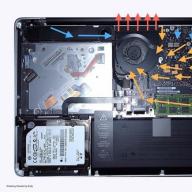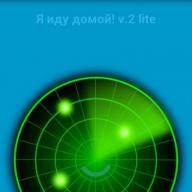More than once I have encountered the problem that the fan is noisy for Apple MacBook Pro, MacBook, MacBook Air laptops, as well as iMac computers. Many customers complain that the MacBook gets hot, over time the fan noise becomes more and more, and when you turn off the laptop, the fan continues to run loudly for some time. To understand this problem, the causes of noise from the fan, and what to do if the fan begins to make noise, this article was written.
1. Why is the fan noisy?
Apple laptops and iMacs use excellent, quiet fans from SUNON. The speed of their rotation depends on how much air flow is needed to cool the processor and other heating parts of the laptop.

Over time, dust and other particles from your life enter through the air intake slots.
Most of them settle on the radiator, which is located after the fan, which cools the main systems - the computer processor and video card processor. Over time, there are so many of them that the amount of air that was required for normal cooling of the system is no longer enough.
The processor begins to overheat and gives a command to increase the air flow. The fan starts spinning faster. At first, you only sometimes hear that the fan has become noisy, but week after week, more and more dust accumulates on the radiator and in front of it, and the lack of cooling causes the fan to increase in speed, up to the maximum. And you already hear noise not sometimes, but always, and the fan is very noisy. Are you wondering what to do?
2. What should I do if the fan is noisy?
This reason will not go away on its own. Attempts to independently remove dust with a home vacuum cleaner through the air intake holes will not lead to success, because... it is necessary to disassemble the laptop/computer, remove the fan (or fans), clean them, clean the radiator from dust, and also, if necessary, replace the thermal paste on the processors. Then put everything back together in reverse order. And, it is desirable that all screws, cables, parts are in place =)
We use special thermal paste; it retains its properties longer and better helps remove heat from the processor.
Disassembling a MacBook on your own can result in damage to expensive parts or system cables, which will lead to repairs that cost much more money than prevention. And it’s not worth it, because... The dust cleaning operation itself is performed in a service center with a guarantee, within a short period of time (usually within 1-3 hours), and is relatively inexpensive, depending on the model - from 1,000 to 2,500 rubles.
We will be happy to answer your questions
We often think that maybe it will go away on its own? Or we wait until the last moment, well, tomorrow, then again tomorrow, etc. however, this can be a very expensive experience. More than once laptops arrived whose processor had already burned out and repairs cost 20-30 thousand rubles. Come right away! And prevention is always cheaper than repair. We are waiting for you at the addresses.
Faulty storage is almost the key cause of all problems with Apple computers: failures in the HDD can cause the loss of important data or even damage the operating system in such a way that it becomes impossible to boot from the hard drive. Of course, the reason for replacing a hard drive can be not only a malfunction, but also the need to expand data storage, so replacing a HDD on Apple computers is not a rare operation.
Unfortunately, in some cases, replacing a hard drive is accompanied by some difficulties in operating the computer. Many users of Apple desktop computers produced since 2009 (in thick Unibody cases) experience iMac noise after replacing the HDD with a third-party hard drive. This is due to the fact that the system cannot correctly read the temperature sensor readings, since the third-party hard drive uses firmware that is incompatible with the iMac (the HDDs built into the iMac, like regular 2.5/3.5 drives, use a built-in sensor, but in third-party drives manufacturers, that is, not intended for installation in Mac by default, these sensors cannot transmit information to the system), due to which the cooler instantly gains maximum speed, and the sound of a running iMac becomes more like a powerful vacuum cleaner.
Order iMac repair |
Call |
Submit your application |
There are two ways to solve this problem: software and hardware.
The software method for eliminating noise is easier to implement, but it is largely fictitious and after updating the system, the problem invariably makes itself felt.
If your iMac is noisy after replacing the HDD, you should use the application smcFanControl to solve the problem, but first you should disconnect the power cable of the temperature sensor. After installing the application (it is advisable to install it in the Applications folder), you need to open the program itself and check the box next to “Autostart smcFanControl after login”, this will allow the application to automatically launch after turning on the computer. As analogues we can offer Macs Fan Controll(which, by the way, works stably even in windows installed via bootcamp - speedfan will most likely not help here).
After this, you will need to find out the number of the cooler responsible for cooling the hard drive. To do this, you need to open a terminal and run the command “/Applications/smcFanControl.app/Contents/Resources/smc -f” without quotes (if the application is installed in another folder, you should specify its path instead of “Applications” at the beginning of the line). If the cooler has not yet gained speed, you should execute the specified command only when noise is heard. If the iMac is constantly noisy after replacing the HDD, one of the “Actual Speed” values for the desired cooler will be close to 6000.
After this you should run the command
where # is the number value of the hard drive cooler. For example, the line might look like “smc -k F1Mx -w 2ee0”.
After the steps are completed, the maximum cooler speed will drop to 3000, which will be enough to effectively cool the hard drive in any conditions. However, after rebooting the system, all these steps will need to be completed again. To get rid of this need, you can set up a script for launching these commands and add it to startup.
To do this, open Automator, select “Utilities” in the “Libraries” section and click “Run shell script”. The parameters must be left as default, and in the field itself enter the command
/Applications/smcFanControl.app/Contents/Resources/smc -k F#Mx -w 2ee0
replacing # with the cooler number. After the script is ready, you need to select the “File” item in the top menu bar, click “Convert to”, select “Program” and save the result to any convenient location.
In order for the script to run every time you turn on the computer, just go to “System Settings”, select “Users and Groups” and open the “Login Objects” section. After that, all that remains is to add the script we created there.
If your iMac is noisy after replacing the HDD even when all the specified steps for adjusting the cooler speed have been completed or a permanent solution to the problem is needed, To eliminate noise you will need to resort to a hardware method.
To begin with, it is worth noting that disabling the HDD cooling cooler, although it eliminates noise, this step will significantly reduce the life of the hard drive and will result in additional problems in the future.
To avoid these problems, you should use a 2n3904 thermal sensor or a prepared analogue on a special transistor, connected via a cable directly to the motherboard. The sensor is mounted on the disk body or in its immediate vicinity and allows you to obtain drive temperature values with sufficient accuracy for the operation of the cooler regulation system. Such an operation is not technically complex, however, due to certain difficulties and the possible lack of necessary components and tools available to the user, it should be entrusted to a service center.
Fair, not overpriced and not underestimated. There should be prices on the Service website. Necessarily! without asterisks, clear and detailed, where technically possible - as accurate and conclusive as possible.
If spare parts are available, up to 85% of complex repairs can be completed in 1-2 days. Modular repairs require much less time. The website shows the approximate duration of any repair.
Warranty and responsibility
A guarantee must be given for any repairs. Everything is described on the website and in the documents. The guarantee is self-confidence and respect for you. A 3-6 month warranty is good and sufficient. It is needed to check quality and hidden defects that cannot be detected immediately. You see honest and realistic terms (not 3 years), you can be sure that they will help you.
Half the success in Apple repair is the quality and reliability of spare parts, so a good service works directly with suppliers, there are always several reliable channels and your own warehouse with proven spare parts for current models, so you don’t have to waste extra time.
Free diagnostics
This is very important and has already become a rule of good manners for the service center. Diagnostics is the most difficult and important part of the repair, but you don't have to pay a penny for it, even if you don't repair the device based on its results.
Service repairs and delivery
A good service values your time, so it offers free delivery. And for the same reason, repairs are carried out only in the workshop of a service center: they can be done correctly and according to technology only in a prepared place.
Convenient schedule
If the Service works for you, and not for itself, then it is always open! absolutely. The schedule should be convenient to fit in before and after work. Good service works on weekends and holidays. We are waiting for you and working on your devices every day: 9:00 - 21:00
The reputation of professionals consists of several points
Company age and experience
Reliable and experienced service has been known for a long time.
If a company has been on the market for many years and has managed to establish itself as an expert, people turn to it, write about it, and recommend it. We know what we are talking about, since 98% of incoming devices in the service center are restored.
Other service centers trust us and refer complex cases to us.
How many masters in areas
If there are always several engineers waiting for you for each type of equipment, you can be sure:
1. there will be no queue (or it will be minimal) - your device will be taken care of right away.
2. you give your Macbook for repair to an expert in the field of Mac repairs. He knows all the secrets of these devices
Technical literacy
If you ask a question, a specialist should answer it as accurately as possible.
So that you can imagine what exactly you need.
They will try to solve the problem. In most cases, from the description you can understand what happened and how to fix the problem.
There may be several reasons why your iMac is humming (noisy) during operation. Extraneous hum and noise when operating an iMac can be caused by four reasons:
- — Wear of the bearings of the main coolers (fans) that are involved in cooling the iMac. This will require a complete cleaning of the iMac's cooling system. More details in the corresponding section
- — Clogging of the working parts of the cooler (fan) with dust and, as a rule, an imbalance of the fan blades. After this, the iMac makes quite a lot of noise (humming) during operation. In most cases, regular cleaning can help, but sometimes you have to change the fan (cooler) due to significant wear on the mechanism. Information on cleaning the monoblock from dust, similar to the previous point, can be found in the section
- — Critical condition of the hard drive (extremely rare). As a rule, hard drives usually don’t survive this long, but occasionally there are situations when the spindle bearings of a hard drive fail before the main mechanics of the HDD. In this case, urgent assistance is required.
- — Failure of temperature sensors (for example, a wire break or a connector falling out). In this case, the entire iMac cooling system goes into protection mode and all cooling fans run at full power until the sensor fault is resolved. In this case, the iMac is noisy (humming) due to the maximum fan speed. Troubleshooting may require repair or replacement of temperature sensors.
- — After replacing the hard drive, the fan began to rotate at a very high speed. In this case, you will only need to install the Macs Fan Control application, which you can download from our server (8.18 MB, OS X 10.7+). You can also watch a help video to fix this problem:
Task:
A customer brought an iMac10.1 21.5 inches. The HDD needs to be replaced.
Problem:
On the new iMac 21.5 and 27 inches, instead of an external hard drive temperature sensor, a special interface is used on the drive itself. A lot of things can be read from it, apparently including information about temperature. When replacing a hard drive, the fan cooling the disk begins to rotate at a speed of 6000 rpm, due to the fact that the computer does not correctly detect the temperature sensor on the new hard drive.
But here are the solutions to this issue that I found on the Internet and not only:
- someone recommended closing the sensor contacts (I didn’t dare experiment on the client aimag)
- someone simply suggested turning off the fan (an interesting solution, of course, but this is vandalism)
- someone installed an external temperature sensor from a previous iMac model and thus solved the problem
- someone recommends installing a hard drive of the same manufacturer and the same series, and everything will be fine (not true)
- someone doesn’t bother at all and works with a noisy iMac :)
- while I was writing the article, I came up with an interesting idea to reduce the fan rotation speed by hardware, i.e. limit the power supply to resistance (this solution will be studied and it’s not even bad)
Let's return to our sheep. The following disk was installed on the client iMac: Seagate ST31000528AS 1Tb Firmware AP24, but we installed this one: Seagate ST31000528AS 1Tb Firmware CC44. Model to model and only the firmware differs, but still the iMac did not recognize the new disk and commanded the fan cooling the disk to rotate fully!
Stages:
1) Disassembly and replacement of the disk. How to disassemble an iMac, see ifixit.com.
When you start installing your new hard drive, DO NOT connect the temperature sensor cable - don't! Just take it out of the iMac and put it on the shelf (yes, yes - like jaws :)
Once you've fully assembled your iMac, turn it on and do some work. After 20-30 minutes you will hear increasing fan noise, thereby you will understand that there really is a problem.
2) Download and install two programs: iStat (Download) and smcFanControl (Download). iStat is provided for convenience, and you will perform the main operations in smcFanControl. Don't forget to check the autorun box:

3) After the iMac starts making noise, you need to find out which fan is making noise and programmatically limit its maximum rotation speed. To do this, go to Terminal and enter the following command there:
<Путь к приложению smcFanControl.app>/Contents/Resources/sm c -f
(for example, I have this address: /Applications/smcFanControl.app/Contents/R esources/smc -f).
This way we will understand which fan is spinning too fast compared to other fans.
You will see something like this, this screenshot was taken on my laptop and it has no problems with the fan speed, so this picture is only for a general idea:

Find a cooler that spins at maximum speed and enter the following command in the Terminal (this command sets the rotation speed of a specific fan):
<Путь к приложению smcFanControl.app>/Contents/Resources/sm c -k<Номер вентилятора с параметром>-w<Скорость вентилятора>
<Номер вентилятора с параметром>
Let's look at the previous picture, for example we need to reduce the maximum rotation speed of Fan #1:
Then<Номер вентилятора с параметром>= F1Mx (F1 = Fan #1, Mx = Maximum)
A<Скорость вентилятора>we will set, for example, 3000 rpm. Why exactly 3000 rpm? Because the rotation speed of the fan cooling the hard drive usually does not exceed 2500 rpm, so 3000 is a reserve.
6200 = 60e0
5600 = 5780
5000 = 4e20
4800 = 4b00
4000 = 3e80
3600 = 3840
3000 = 2ee0
2500 = 2710
And our team takes on the following form:
<Путь к приложению smcFanControl.app>/Contents/Resources/sm c -k F1Mx -w 2ee0
(For me this command looks like this: /Applications/smcFanControl.app/Contents/R esources/smc -k F1Mx -w 2ee0)
There is one last stage left; after a reboot, all parameters will be lost. Accordingly, it is necessary to ensure that this command is registered automatically during system boot.
4) Let's write a small application that will limit the maximum fan rotation speed when the system boots. For this
open Automator, if you don’t know where to find it, just write it in the search. Next, in Automator, do the following steps:
Custom > Utilities > Run Shell Script
and write in place of cat, the command we came to in the previous paragraph:

5) Last stage. Autostart our application upon loading. For this:
System Preferences > Accounts > Login Items
Click on the plus sign and add our application to startup. Yes, don't forget to check the box next to our application.
Enjoy the peace and quiet!
- Good luck!
P.S. If anyone has any ideas on how to merge the firmware from the old disk and upload it to a new one (if at all possible) or anything else, please sign up - people will not forget you :)




